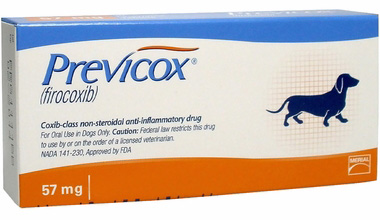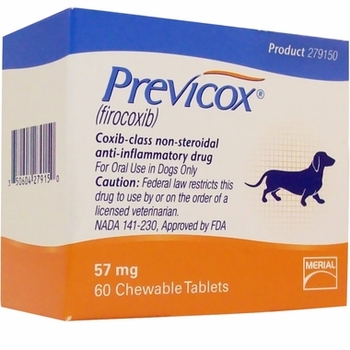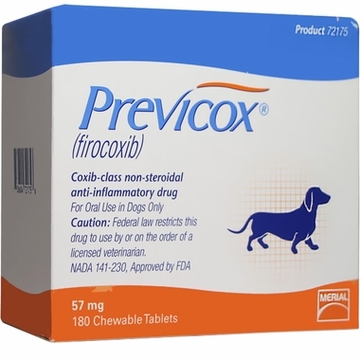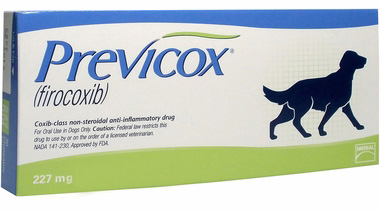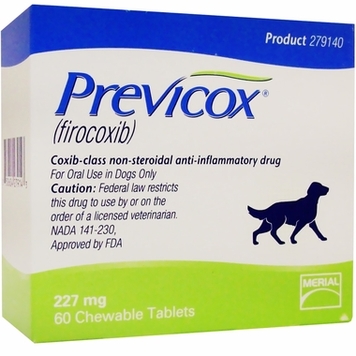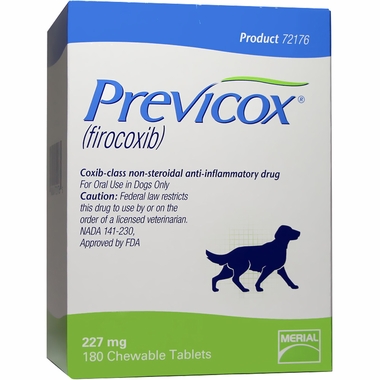Pet Health Article |
PREVICOX (firocoxib) Frequently Asked QuestionsWhat should I tell or ask my veterinarian before giving my dog PREVICOX (firocoxib)?
Talk with your veterinarian about:
Tell your veterinarian about:
How do I give PREVICOX (firocoxib) to my dog? PREVICOX should be given according to your veterinarian’s instructions. Do not change the way you give PREVICOX to your dog without first speaking with your veterinarian. Your veterinarian will tell you what amount of PREVICOX is right for your dog and for how long it should be given. Most dogs will take PREVICOX chewable tablets from your hand, but you can also place the tablet directly into your dog’s mouth. PREVICOX may be given with or without food. What should I do in case my dog consumes more than the prescribed amount of PREVICOX (firocoxib)? Consult your veterinarian immediately if your dog consumes more than the prescribed amount of PREVICO Are there possible side effects that may occur in my dog during treatment with PREVICOX (firocoxib)? PREVICOX, like other NSAIDs, may cause some side effects. Serious side effects associated with NSAID therapy in dogs can occur with or without warning. The most common side effects associated with PREVICOX therapy involve the digestive tract (vomiting and decreased food consumption). Liver and kidney problems have also been reported with the use of NSAIDs. Look for the following side effects that may indicate your dog is having a problem with PREVICOX or may have another medical problem in addition to arthritis.
It is important to stop treatment and contact your veterinarian immediately if you think your dog has a medical problem or side effect while taking PREVICOX tablets. If you have additional questions about possible side effects, talk with your veterinarian or call 888-637-4251. Can PREVICOX (firocoxib) be given with other medications? PREVICOX should not be given with other NSAIDs (for example, aspirin, carprofen, etodolac, deracoxib, meloxicam, or tepoxalin) or corticosteroids (for example, prednisone, cortisone, dexamethasone, or triamcinolone). Tell your veterinarian about all medications that you have given your dog in the past, and any medications that you are planning to give. This should include other medicines that you can get without a prescription or any dietary supplements. Your veterinarian may want to check that all of your dog’s medicines and supplements can be given together. Which dogs should not take PREVICOX (firocoxib)? Your dog should not be given PREVICOX if he/she:
Are some dogs more vulnerable to arthritis than others? There is a greater incidence of arthritis in older dogs and among the larger breeds, but it may occur in small and toy breeds as well. Dogs of any breed, including mixed-breed dogs, and those of any size, weight and age can show signs of canine OA. Can arthritis in dogs be cured? Unfortunately, there is no definitive cure for arthritis in dogs, but the pain and inflammation associated with it can be treated. Learn about Arthritis How common is arthritis in dogs? It has been estimated that arthritis affects 1 in every 5 dogs over the age of one year. How will my veterinarian diagnose osteoarthritis in my dog? In addition to observing and discussing signs of OA, such as limping and changes in behavior with you, your veterinarian has several diagnostic tools available for determining whether your dog has arthritis. Your veterinarian may conduct an orthopedic exam to ascertain the presence of joint pain, swelling, and/or tenderness. He or she may also take an x-ray that can show bone changes that would be related to OA. Read more information on what to expect and how to prepare for an OA examination here. What causes arthritis in dogs?Age, injury, “wear and tear” and developmental abnormalities are some of the typical causes of arthritis in dogs. What are the signs of arthritis in dogs? Because of the inflammation associated with OA, most of the signs of this disease in dogs are related to the pain and reduced mobility of the affected joints and the dog’s reluctance to cause more pain by moving. Though not all dogs with OA will display obvious signs of pain, many do show signs of stiffness, limping, and lethargy. It’s important to pay close attention to changes in your dog’s activity and behavior. What can I do if I think my dog has arthritis? If you suspect your pet should be evaluated for OA, ask your veterinarian to examine your dog. Should your veterinarian diagnose your dog with OA, ask for information about treatment options for the pain and inflammation associated with canine OA, including PREVICOX (firocoxib). Follow your veterinarian’s recommendations. |
